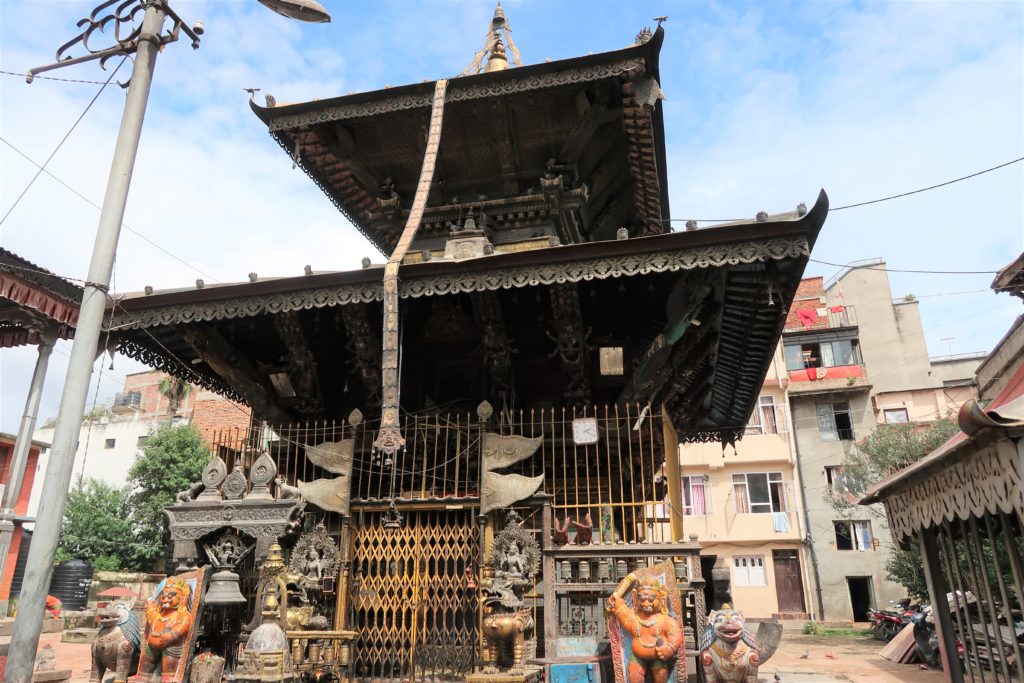パタン Patan のラトマチェンドラナート寺院 Rato Machhendranath Temple のすぐ近くに、ジェスタバーナ マハビハール ミンナート寺院 Jestha Varna Mahavihar Min Nath Temple (ミンナート寺院 Min Nath Temple)が在ります。 Lonely Planet による Minnath Temple の紹介は以下の文章です。
Lonely Planet による Minnath Temple の紹介は以下の文章です。
Just 200m south of I Baha Bahi, a large water tank marks the entrance to a courtyard strewn with wooden beams. In the centre is the brightly painted, two-tiered Minnath Temple, dedicated to the Bodhisattva Jatadhari Lokesvara, who is considered to be the little brother of Rato Machhendranath. The temple was founded in the Licchavi period (3rd to 9th centuries), but the multi-armed goddesses on the roof struts were added much later.
Note the metal pots and pans nailed to the temple rafters by devotees. The timbers surrounding the temple are assembled into a chariot every year to haul the statue of Minnath around town as part of the Rato Machhendranath Festival.
マチェンドラナート寺院との深い関わりがある様で、人々はマチェンドラナート寺院にお参りに行く前に、このミンナート寺院にお参りする様です。マチェンドラナート寺院とミンナート寺院の関係については、お祭り Rato Macchendranath Jatra の 山車 chariot についての説明に合わせて、The Himalayan Times の「 Readying for Rato Machhindranath Jatra」の記事で、
Many of us must have seen a small chariot near Machhindranath’s chariot. This is the chariot of Minnath — another deity. This deity is considered as Padmanityeshwor — a form of Shiva — a Hindu deity. We may have heard of the mythical relation between Minnath and Machhindranath as maternal uncle and nephew. However, Rabin Shakya, a priest at Minnath temples explains, “There is no such relation between these two deities. Machhindranath is the guest here who was brought to the country from Kamaru Kamakhya, India.”
との説明もあります。
 寺院としての建築様式も、カトマンズやパタンのマチェンドラナート寺院とよく似ています。ECS NEPALの「It All Starts with the Yantra」の記事で、類似点の記載を見つけることが出来ます。
寺院としての建築様式も、カトマンズやパタンのマチェンドラナート寺院とよく似ています。ECS NEPALの「It All Starts with the Yantra」の記事で、類似点の記載を見つけることが出来ます。
Both roof levels of the Matsyendranath Temple in Jana Bahal of Kathmandu have lovely kikkinmalas and one can observe figures of four powerful gods, Birudhaka, Dhritastra, Vaisravana and Viropaksha, at its four corners. Similar dominant figures can also be seen at some other temples such as the Min Nath Temple in Tangal, Patan, where two demonic figures stand guard at the front gate and two others at the temple entrance. This temple has copper sheeted roofs, as has the Matsyendranath Temple in Ta Bahal of Patan.
この記事は建築様式に関する詳細な記述が満載です。オーバーハングした屋根を支える Struts (Tundal トゥンダール 方丈)の彫刻について、どの位置の Strutsに何が彫られるかや、性的な彫刻の意味などにも言及しています。
One myth says that the erotic figures were carved to protect the temples from the wrath of a great puritan queen during the days of the Mahabharata War; another says that Hinduism’s most lusty god, Indra, will not let his bolt (bajra) strike places where there is something erotic (thus protecting such temples from lightning).
屋根の先端の Gajura ガジュラ(ガジュール)についての説明でも、ミンナート寺院が登場します。
Very heavy looking gajurs adorn the Min Nath and the Matsyendranath Temples of Patan.
Gajuraから垂れ下がるPataka パタカ(Dhvaju ドバジャ)の項目でも、再度ミンナート寺院が取り上げられています。
The pataka (dhvaju) is mostly made of gold, silver or copper and the eight auspicious symbols (asta mangala: endless knot, lotus, banner, wheel, holy water jug, pair of fish, parasol and conch shell) are popularly used as its design. They are supposed to be pathways for gods to descend down to earth. The intricately designed patakas of Ratnakar Mahavihara and Min Nath Temples in Patan are very impressive.

「Jestha Varna Mahavihar Min Nath Temple (Min Nath Temple) ミンナート寺院 (Patan)」への1件のフィードバック
コメントは受け付けていません。